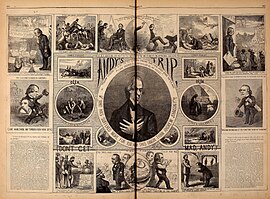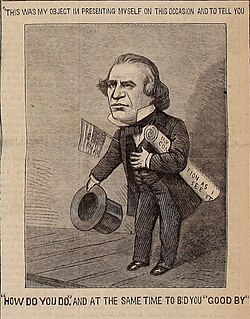User:Jengod/ThNastRadical
| Andy's Trip | |
|---|---|
 | |
| Artist | Thomas Nast |
| Completion date | 27 October 1866 |
| Medium | Woodcut |
| Dimensions | 34.61 cm × 52 cm (13.625 in × 20.5 in) |
| Website | Harper's Weekly (loc.gov) |
Andy's Trip is a multi-panel political cartoon by American artist Thomas Nast depicting the 1866 electioneering trip of Andrew Johnson that came to known as the Swing Around the Circle. Published as a double-page spread in the October 27, 1866 issue of Harper's Weekly The image "delivered a blow"[1] and served as a "visual indictment of Johnson's behavior during his swing around the circle, divided by two dozen panels, with Johnson at the center wearing a halo and smiling beneath the words, a takeoff from his New York speech: 'Who has suffered more for you and for this Union than Andrew Johnson?'"[2] According to historian Fiona Holloran, "Hammering away, Nast insisted that it was Johnson who 'forgot' Union veterans and Union families."[1]
Rhetoric professor Brett Warnke puts Andy's Trip in a class of memorably ruthless takedowns of American presidents, along with works like Hunter S. Thompson's obituary of Richard M. Nixon and H. L. Mencken's commentary on the speeches Warren G. Harding.[3] Per Warnke, Johnson's behavior on the Swing "astonished the country. This hack was the President? Lincoln's heir? The nation's healer? ...Johnson, a half-literate East Tennessee tailor who delivered the same speech that was printed in the papers before he arrived, met crowds longing for something more than a Pretender's rehearsed and pitifully inarticulate wind...Nast scratched away any illusions about Johnson, revealing him as the petty, tempestuous, nasty little puke he was, in cartoons like Andy's Trip, where he mocks Johnson's faux martyrdom."[3]

Over the course of the almost three week tour, Johnson had compared himself to Jesus: "Yes...over 1800 years ago, there was a man who...descended from on high and finding that the whole world was condemned and sentenced under the law...put himself upon the cross and attested by his wounds and his blood, and there declared, instead of putting the world to death: 'I will die that man may live.' [Applause] 'Then if I have erred, it is in that.'"[4] while "not once did he mention Lincoln" only referring to "his predecessor."[5] At one point during his speech in Niagara Falls, according to the Weekly Journal of Fremont, Ohio, said "'...friends of the country, friends that were personal to me, were anxious that I should be placed on the ticket, I was placed there; I accepted it; the race was run, the victory was obtained, and I was made Vice-President of the United States. Can't you see the gradation comes along regularly? And, then, by the Constitution of the country, I have been made President. I am glad of it.'"[6] The Fremont Weekly Journal editorialized, "Considering the circumstances under which Mr. Johnson came to be President of the United States, he could not have made use of a more unfortunate expression."[6]
According to historian Gregg Phifer, this self-obsession ironically benefitted his political adversaries:
Radical politicians, preachers, and editors found the President a vulnerable target, more vulnerable than his policies. Johnson rose to the bait, complaining over and over again, as at St. Louis, 'I have been traduced, I have been slandered, I have been maligned..." Much of his speaking time was devoted to Radical charges of excessive pardons, tyrannical use of the veto, usurpation of the congressional prerogative in reconstruction, lack of United States citizenship, misuse of the federal patronage, and betrayal of the party that elected him. And the more time he spent in self defense, the less he could use for debate on Negro suffrage, the fourteenth amendment, economy, and other issues the Radicals would rather postpone until after the election.[5]
One editorial writer described the tour as revealing Johnson as "the first of our chief magistrates who believed in the brutality of the people and gave to the White House the ill-savor of a corner-grocery."[7]
| Image | Caption text | Additional information |
|---|---|---|

|
"This gang of office-holders, these bloodsuckers and cormorants had got fat on the country." Cincinnati speech at Kennard House[8] | In seeking to use patronage jobs and the spoils systems to his own benefit, Johnson "removed 1283 postmasters and made similar decapitations in the custom-houses and internal revenue offices". However many of these jobs had gone to injured war veterans during the Lincoln administration, while Johnson hired "men who opposed the war throughout", which caused its own set of political problems. [9] |

|
("What does General Sheridan say?") ("New-Orleans.") "Trace it back to the radical Congress." | Nast references the crowds asking if Andrew Johnson suppressed part of Gen. Philip Sheridan's report about the New Orleans massacre. (He did.)[10] Johnson claimed that Congressional Republicans had instigated the civil disorder. According to historian Phifer, "The President's evidence was weak. He could not prove that Radical politicians had directly incited the riot. He could only show how well the event served their interests."[11] |

|
"Bring a balm and oil from Gilead." "A balm that is healing in its character and pour it on the wound?" | A reference to balm of Gilead, mentioned in Jeremiah 8#Verse 22 and elsewhere in the Bible. Nast's Johnson (with a veto in his back pocket) tends to a wounded Confederate with "pardon oil" and "Southern rights" while a soldier of the U.S. Colored Troops (with a decapitated arm) cries for help alongside other Union wounded under a U.S. flag. Johnson had said to the crowd in Albany, New York, "Let me ask the soldier scarred in battle, or who has lost a limb, does he still desire to keep up the scenes of war and conflict? Does he want one portion of the country to be again arrayed against the other? Do we desire to reopen the arteries, and start the wound afresh, or do we desire to go to Gilead and bring the balm or oil in order to heal the wound, or do we desire again to see man lift his hand against the throat of his fellow?"[12] |

|
"There are few men who have been abandoned by the people unless they have deserted them first." (That's so.) | As soon as Johnson left New York his speeches were met by increasingly hostile crowds; "the honeymoon was over; the swing around the circle headed toward trouble."[13] Among many other incidents, crowds in Ashtabula and New Market, Ohio; Bloomington and Indianapolis, Indiana; and Pittsburg, Pennsylvania entirely "refused a hearing" to the President.[14] |

|
(This same mayor is running for governor.) (Our mare takes him through New York City.) | Johnson rides New York City "mare" Fernando Wood past Delmonico's. |

|
"This was my object in presenting myself to you on this occasion and to tell you ' How do you do' and at the same time bid you 'good-by.'" | Johnson said this during his Cleveland speech; during this event, someone in the crowd called him a traitor, someone yelled "Unfortunately" when Johnson mentioned Lincoln had put him on the ticket, and when he told the crowd he was trying to figure out who was in wrong, someone hollered, "It's you!"[15] |

|
("Hang Jeff Davis.") "Then I would ask you, why not hang Thad Stevens and Wendell Philips." | Nast is quoting from an exchange between the crowd and Johnson at Cleveland. Among other things Unionists had spent the better part of the war singing "Oh we'll hang Jeff Davis from a sour apple tree." Rather than offering them any satisfaction, Johnson returned to a theme he'd hit for years: that abolitionists and secessionists were equally pernicious forces for disunion.[16] (Ergo, Jefferson Davis, Thaddeus Stevens, and Wendell Phillips were all equally deserving of capital punishment for treason.) |
See also[edit]
- There Is a Balm in Gilead – Traditional African American spiritual
References[edit]
- ^ a b Holloran (2013), p. 97.
- ^ Boulard, Garry (April 5, 2021). Andrew Johnson: The Renaissance of an American Politician. ISBN 978-1-6632-2030-1.
- ^ a b Warnke, Brett (May 17, 2017). "Embrace the Hate". OB Rag. Retrieved 2024-01-09.
- ^ Phifer (1952b), p. 153.
- ^ a b Phifer (1952b), p. 165.
- ^ a b "Glad of it". The Fremont Weekly Journal. September 14, 1866. p. 2. Retrieved 2024-01-05.
- ^ "History of the United States from the Compromise of 1850. v.5". HathiTrust. p. 620. Retrieved 2024-01-05.
- ^ "The President's Tour". The New York Times. September 5, 1866. p. 8. Retrieved 2024-01-19.
- ^ Stebbins (1913), pp. 117–118.
- ^ Trefousse, Hans L. (1997). Andrew Johnson: A Biography. New York: W. W. Norton & Co. pp. 259 (New Orleans). ISBN 978-0-393-31742-8. LCCN 88028295. OCLC 463084977.
- ^ Phifer (1952b), p. 152.
- ^ "The Presidential Tour". The Day Book. September 1, 1866. p. 2. Retrieved 2024-02-10.
- ^ Phifer (1952d), p. 13.
- ^ Phifer (1952d), p. 18.
- ^ "Johnson: The Accidental President Makes a Long-Winded Harangue at Cleveland, Ohio". The True Democrat. September 11, 1866. p. 2. Retrieved 2024-02-10.
- ^ "Andrew Johnson on the twin evils". The Cadiz Sentinel. April 30, 1862. p. 1. Retrieved 2024-02-10.
Sources[edit]
- Halloran, Fiona Deans (2013). Thomas Nast: The Father of Modern Political Cartoons. UNC Press Books. ISBN 978-0-8078-3735-1.
- Phifer, Gregg (1952a). "Andrew Johnson Takes a Trip". Tennessee Historical Quarterly. 11 (1): 3–22. ISSN 0040-3261. JSTOR 42621094.
- Phifer, Gregg (1952b). "Andrew Johnson Argues a Case". Tennessee Historical Quarterly. 11 (2): 148–170. ISSN 0040-3261. JSTOR 42621106.
- Phifer, Gregg (1952c). "Andrew Johnson Delivers His Argument". Tennessee Historical Quarterly. 11 (3): 212–234. ISSN 0040-3261. JSTOR 42621112.
- Phifer, Gregg (1952d). "Andrew Johnson Loses His Battle". Tennessee Historical Quarterly. 11 (4): 291–328. ISSN 0040-3261. JSTOR 42621739.
- Stebbins, Homer Adolph (1913). A political history of the state of New York, 1865–1869. Studies in History, Economics and Public Law. New York: Columbia University.
